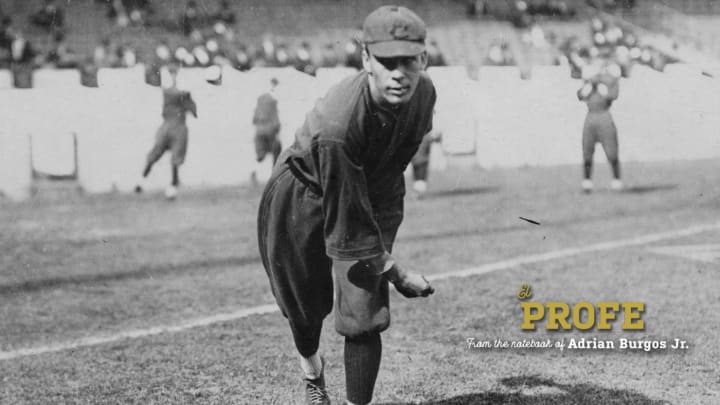El Profe: Cubans’ Big League Arrival
By Adrian Burgos

“Two of the Purest Bars of Castilian Soap.” That is how one Cincinnati newspaper described the two Cuban players who made their major league debut for the Reds during an Independence Day doubleheader versus the Cubs in 1911.
The Reds’ newcomers might have been major league rookies, but Rafael Almeida and Armando Marsans also represented something else that was acknowledged as new.
Unlike Esteban “Steve” Bellán’s participation in the National Association in the early 1870s or the Havana-born and Chicago-raised Charles “Chick” Pedroes’ two-game big league career, Almeida and Marsans were the first Cubans who were the product of Major League Baseball’s engagement with Cuban baseball.
The Reds’ Cuban duo was not alone.
Throughout the 1910s other Cubans would join Almeida and Marsans in the majors. Included among the 12 Cubans to debut during the 1910s were Adolfo “Dolf” Luque, winner of 194 games in the majors, and Miguel Angel González, who enjoyed a 17-year playing career.
The increasing participation of Cubans was not without controversy. Some fans, sportswriters, and white American players wondered, sometimes aloud and other times in whispers: Were these Cubans white?
Color Line Alterations
Coverage of the new Reds players was notable partly in the way sportswriters tried to explain what was unfamiliar to many baseball fans in Cincinnati and across the United States.
Their words revealed how they tried to make sense of the appearance of “bronze-skinned” islanders in the racially-segregated league. They also reveal how certain sportswriters sought to allay concerns of fans that these players’ appearance did not mean that black players had snuck into the major leagues.
Also significant, the manner in which the baseball press handled the introduction of Almeida and Marsans to the Cincinnati fans and the rest of the National League circuit reveals how MLB’s color line would be maintained even as a few Latin American-born players gained access.
Cincinnati’s Cuban Connection
Entering midway through the opening game of the July 4 doubleheader, Almeida collected a hit in two turns at the plate while taking over at third base for the Reds. Coming in to play right field, Marsans also got a hit in two plate appearances. Despite the Cubans’ success at the plate, the Reds dropped the game 8-3 to the Cubs.
More notable than their performance was that the two Cubans were evidence of the connection that the Reds had established with Cuban baseball. That connection had been made by Cincinnati’s business manager Frank Bancroft.
Bancroft was quite familiar with Cuban baseball. In 1879 he had led the Hop Bitters team on a winter 1879 tour of Cuba—the first team of U.S. professional players to perform on the island versus Cubans.
Over the next three decades, Bancroft would return with teams to Cuba, including in December 1910 when he took the Philadelphia Athletics on a tour as a favor to its manager, Connie Mack.
Almeida and Marsans caught Bancroft’s attention. He wrote Reds president August “Garry” Herrman about the Cuban duo from Havana.
Bancroft’s letter included a scouting report with two significant descriptions of Almeida.
First, he described Almeida as “a corker” (a good hitter) and stated “wish we had him.”
Just as significant, Bancroft informed his boss that the Cuban infielder “is not colored” and that he had spent the 1910 season playing for New Britain in the Connecticut League.
Seeing Race and Color
The Cincinnati sportswriter who described Almeida and Marsans as “two of the purest bars of Castilian soap that ever floated upon these shores” had reason to do so.
There was some concern in U.S. baseball circles that the Reds were trying to pull a fast one, slipping in the Cubans past those who supported baseball’s racial exclusionary color line.
One sportswriter who covered the Connecticut League was among those expressing concerns, writing about Almeida:
“Were he a white man, he might be good for the show … But I find the presence of these Cubans breed discontent here and I think it would do so even more on a major league club.”
A New York Times column also illustrated racial views that colored the perceptions of many white Americans, reporting on the “surprise” of New York fans who had expected Almeida and Marsans would “look like Pullman porters.”
A Familiar Difference
Racial perceptions of white Americans about Cubans prompted a response from Reds team officials and from within the sporting press. Specifically, it was the view that the two new Cubans on the Reds were perhaps not white and actually closer to black. Hence, it questioned whether Almeida and Marsans were truly eligible to play in the major leagues.
Cuban sportswriter Victor Muñoz tried to address such concerns, writing to Reds president of Almeida and Marsans: “Both of these men are pure Spaniards, without a trace of colored blood.”
Addressing those who worried about the Reds’ new Cubans inspired the creativity of one Cincinnati Enquirer sportswriter.
Cincinnati was home of Proctor and Gamble, the manufacturer of Ivory soap which was advertised as “99 44/100 percent pure.” The sportswriter seized on this to describe the Reds’ Cuban duo in a way familiar to Cincinnatians.
The Cubans were thus presented as “purest bars of Castilian soap.”
And for those who did not quite get the racial significance of that description, the sportswriter added that the two were of “a noble Spanish race, with no ignoble African blood to place a blot or spot on their escutcheons [family crest].”
That description made the two Cubans a bit more familiar and addressed the racial unease.
But Almeida and Marsans would still need to prove they deserved to be on the field as players all the while still dealing with others who remained not fully convinced that the Cubans were white and should have been allowed in the majors.
Featured Image: Library of Congress
Inset Image: Library of Congress